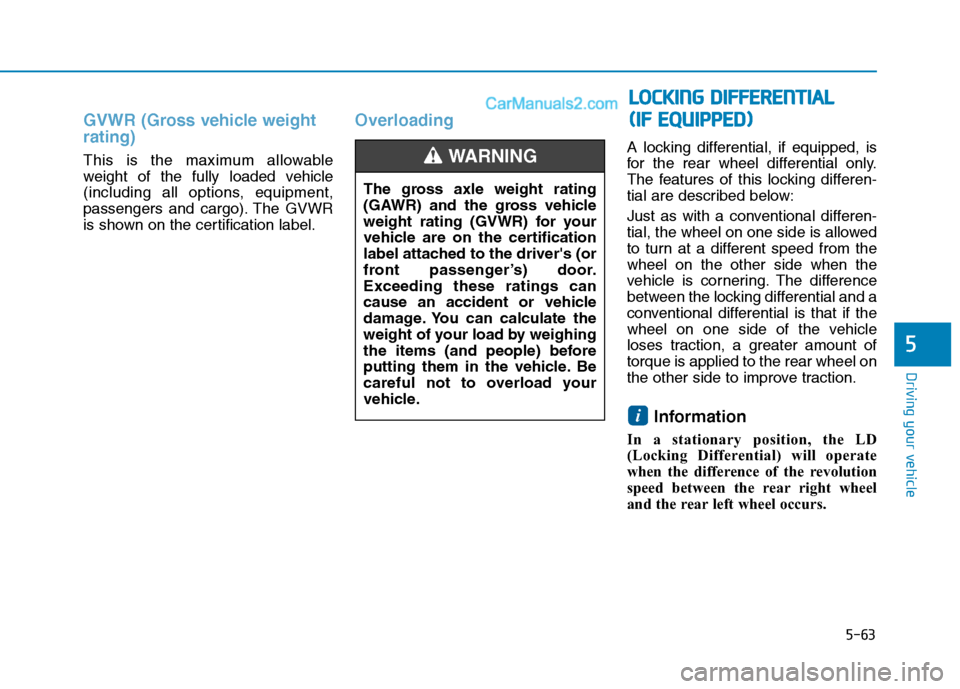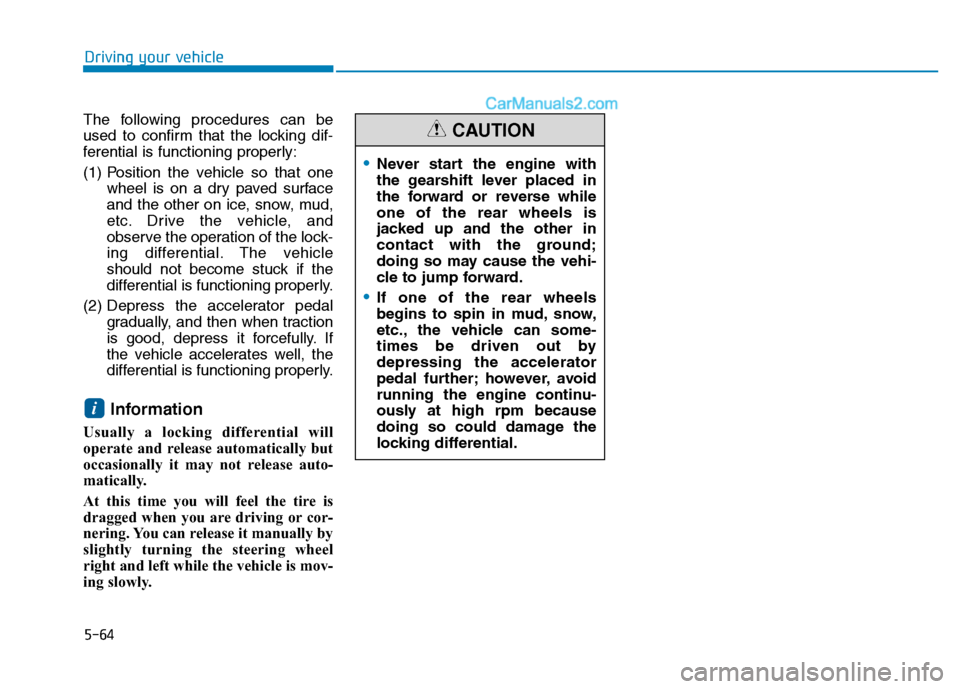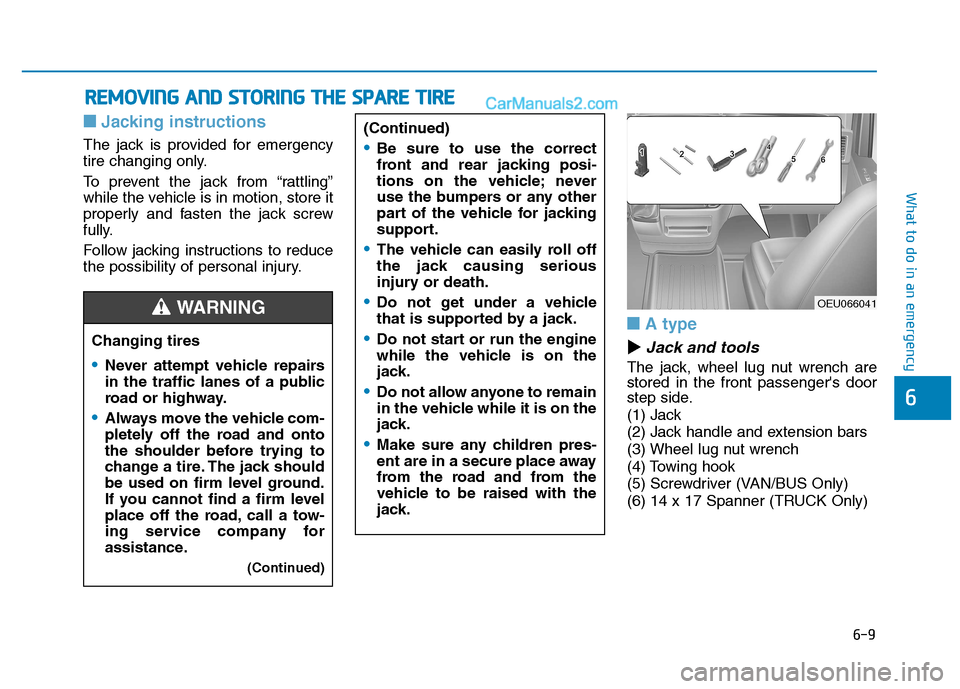Page 331 of 473
5-60
Driving your vehicle
ItemBus
Va n
Truck
N1* 1
N2*1
Long Long Short Long Short Long Short
Overall length mm(inch) 6,195
(243.9) 6,195
(243.9) 5,515
(217.1) 6,195
(243.9) 5,515
(217.1) 6,167
(242.8) 5,724
(225.4)
Maximum trailer
weight kg(lbs.) Without
brake
System 750 (1,653) 750 (1,653) 750 (1,653) 750 (1,653) 750 (1,653) 750 (1,653) 750 (1,653)
With brake System 2,500
(5,511) 3,000
(6,613) 3,000
(6,613) 2,500
(5,511) 2,500
(5,511) 3,000
(6,613) 3,000
(6,613)
Maximum permissible
static vertical load on
the coupling device kg(lbs.) 100 (220) 120 (264) 120 (264) 100 (220) 100 (220) 120 (264) 120 (264)
Recommended distance fromrear wheel center to coupling
point mm(inch) 1,686 (66.4) 1,686 (66.4) 1,241 (48.9) 1,686 (66.4) 1,241 (48.9) 1,756 (69.1) 1,548 (60.9)
The chart contains important considerations that have to do with weight: ❇
*1
: N1:GVW 3.5 ton, N2 : 3.5 ton < GVW <12 ton
�
Page 334 of 473

5-63
Driving your vehicle
5
GVWR (Gross vehicle weight rating)
This is the maximum allowable
weight of the fully loaded vehicle
(including all options, equipment,
passengers and cargo). The GVWR
is shown on the certification label.
Overloading
A locking differential, if equipped, is
for the rear wheel differential only.
The features of this locking differen-
tial are described below:
Just as with a conventional differen-
tial, the wheel on one side is allowed
to turn at a different speed from thewheel on the other side when the
vehicle is cornering. The difference
between the locking differential and a
conventional differential is that if the
wheel on one side of the vehicle
loses traction, a greater amount oftorque is applied to the rear wheel on
the other side to improve traction.Information
In a stationary position, the LD
(Locking Differential) will operate
when the difference of the revolution
speed between the rear right wheel
and the rear left wheel occurs.
i
The gross axle weight rating
(GAWR) and the gross vehicle
weight rating (GVWR) for your
vehicle are on the certification
label attached to the driver's (or
front passenger’s) door.Exceeding these ratings can
cause an accident or vehicle
damage. You can calculate the
weight of your load by weighing
the items (and people) before
putting them in the vehicle. Be
careful not to overload your
vehicle.
WARNING
LL OO CCKK IINN GG DD IIFF FFEE RR EENN TTIIAA LL
(
( IIFF EE QQ UUIIPP PP EEDD ))
Page 335 of 473

5-64
Driving your vehicle
The following procedures can be
used to confirm that the locking dif-
ferential is functioning properly:
(1) Position the vehicle so that onewheel is on a dry paved surface
and the other on ice, snow, mud,
etc. Drive the vehicle, and
observe the operation of the lock-
ing differential. The vehicle
should not become stuck if the
differential is functioning properly.
(2) Depress the accelerator pedal
gradually, and then when traction
is good, depress it forcefully. If
the vehicle accelerates well, the
differential is functioning properly.
Information
Usually a locking differential will
operate and release automatically but
occasionally it may not release auto-
matically.
At this time you will feel the tire is
dragged when you are driving or cor-
nering. You can release it manually by
slightly turning the steering wheel
right and left while the vehicle is mov-
ing slowly.
i
Never start the engine with
the gearshift lever placed in
the forward or reverse whileone of the rear wheels is
jacked up and the other in
contact with the ground;
doing so may cause the vehi-
cle to jump forward.
If one of the rear wheels
begins to spin in mud, snow,
etc., the vehicle can some-
times be driven out bydepressing the accelerator
pedal further; however, avoid
running the engine continu-
ously at high rpm because
doing so could damage the
locking differential.
CAUTION
Page 344 of 473

6-9
What to do in an emergency
6
■■Jacking instructions
The jack is provided for emergency
tire changing only.
To prevent the jack from “rattling”
while the vehicle is in motion, store it
properly and fasten the jack screw
fully.
Follow jacking instructions to reduce
the possibility of personal injury.
■■A type
��Jack and tools
The jack, wheel lug nut wrench are stored in the front passenger's door
step side.
(1) Jack
(2) Jack handle and extension bars
(3) Wheel lug nut wrench
(4) Towing hook
(5) Screwdriver (VAN/BUS Only)
(6) 14 x 17 Spanner (TRUCK Only)
RREEMM OOVVIINN GG AA NN DD SS TT OO RRIINN GG TT HH EE SS PP AA RREE TT IIRR EE
OEU066041
Changing tires
Never attempt vehicle repairs
in the traffic lanes of a public
road or highway.
Always move the vehicle com-
pletely off the road and onto
the shoulder before trying to
change a tire. The jack should
be used on firm level ground.
If you cannot find a firm level
place off the road, call a tow-
ing service company for
assistance. (Continued)
(Continued)
Be sure to use the correct
front and rear jacking posi-
tions on the vehicle; never
use the bumpers or any other
part of the vehicle for jacking
support.
The vehicle can easily roll off
the jack causing serious
injury or death.
Do not get under a vehicle
that is supported by a jack.
Do not start or run the engine
while the vehicle is on the
jack.
Do not allow anyone to remain
in the vehicle while it is on the
jack.
Make sure any children pres-
ent are in a secure place away
from the road and from the
vehicle to be raised with the
jack.
WARNING
Page 347 of 473
6-12
■■B type
��Jack and tools
The jack, wheel lug nut wrench are stored in the front passenger's door
step side.
(1) Jack
(2) Jack handle and extension bars
(3) Wheel lug nut wrench
(4) Towing hook �
VAN/BUS
Your spare tire is stored underneath
your vehicle, directly below the cargoarea.
To remove the spare tire:
1.Open the rear doors.
2.Find the plastic hex bolt cover and
remove the cover. 3.Using the wheel lug nut wrench,
unscrew the bolts counter-clock-
wise. Be careful not to drop the
carrier rapidly.
4.After the spare tire carrier reaches the ground, remove the spare tire
outside from the carrier.
What to do in an emergency
OEU064041OEU064022OEU064023
Page 348 of 473
6-13
What to do in an emergency
To store the spare tire:
1.Carefully place the spare tire ontothe spare tire carrier (1) with the
valve stem facing down.
2.Raise the spare tire carrier with the hold bolt assemblies.
3.Turn the hold bolt (2) assemblies clockwise until it tighten the speci-
fied torque.
[9.6~14.4 kgf.m(69~104 lb.ft)] �Truck
Your spare tire is stored underneath
your vehicle, directly below the cargoarea.
To remove the spare tire:
1.Loosen fender nuts (1) manually
and then remove them.
2.Using the wheel lug nut wrench, unscrew the nuts (2) counter-clock-
wise.
Be careful not to drop the carrier
rapidly.
3.After the spare tire carrier reaches the ground, remove the spare tire
outside from the carrier.
6
OEU065051OEU065052OEU065053
Page 349 of 473
6-14
To store the spare tire:
1.Carefully place the spare tire onto
the spare tire carrier (4) with the
valve stem facing down.
2.Raise the spare tire carrier with the hook assemblies (3).
3.Turn the nuts (2) clockwise until it tighten the specified torque.
[1.2~1.8 kgf.m (8.7~13.0 lb.ft)]
4.Put fender nuts (1) in place and tighten them.
Changing tires
1.Park on a level surface and applythe parking brake firmly.
2.Shift the shift lever into R (Reverse) with manual transmis- sion.
3.Activate the hazard warning flash- er.
4.Remove the wheel lug nut wrench, jack, jack handle, and spare tire
from the vehicle.
5.Block both the front and rear of the wheel that is diagonally opposite
the jack position.
What to do in an emergency
OEU065054
OEU064032
Ensure the spare tire carrier is
properly aligned with the center
of the spare tire to prevent the
spare tire “rattling”. Otherwise,
it may cause the spare tire tofall off the carrier and lead to anaccident.
WARNING
Page 350 of 473
6-15
What to do in an emergency
6
6.Loosen the wheel lug nuts counter-clockwise one turn each, but do
not remove any nut until the tire
has been raised off the ground.
7.Place the jack at the front or rearjacking position closest to the tire
you are changing. The jack should
be positioned as shown in the
drawing.
Changing a tire
To prevent vehicle movement
while changing a tire, always
set the parking brake fully,
and always block the wheel
diagonally opposite the wheel
being changed.
We recommend that the
wheels of the vehicle be
chocked, and that no person
remain in a vehicle that is
being jacked.
WARNING
OEU064012OEU064024
■
FRONT TIRE
OEU064025
■REAR TIRE